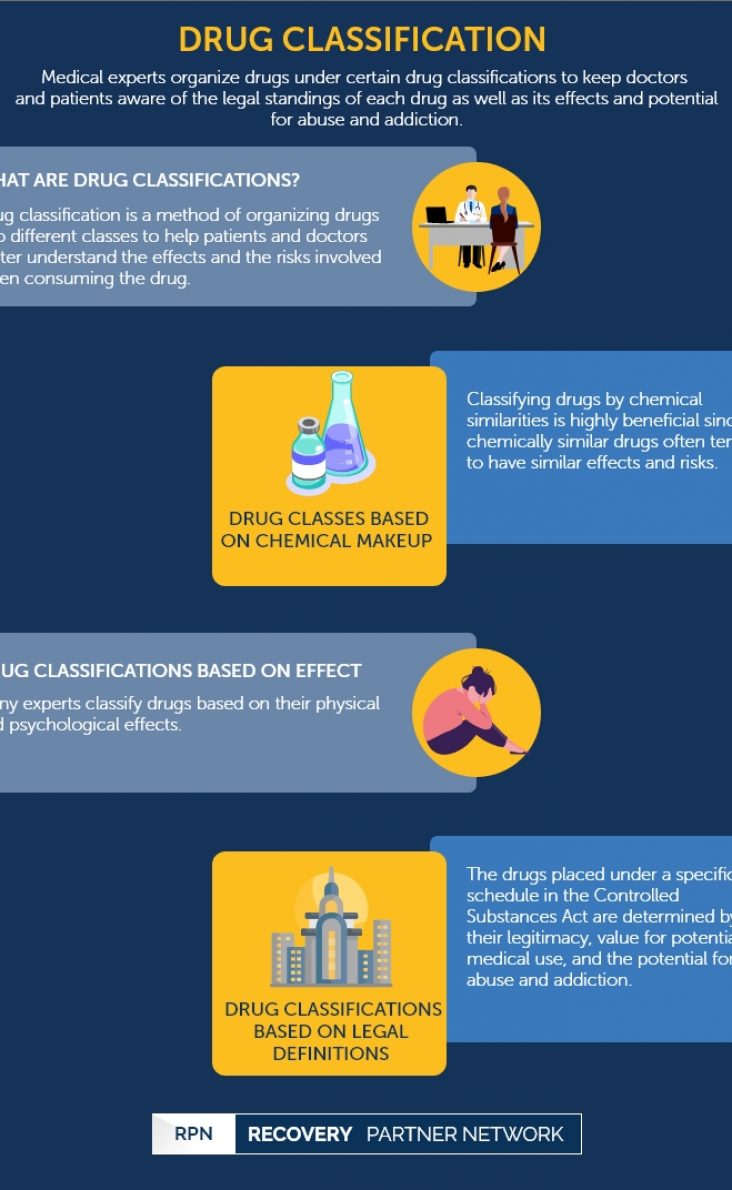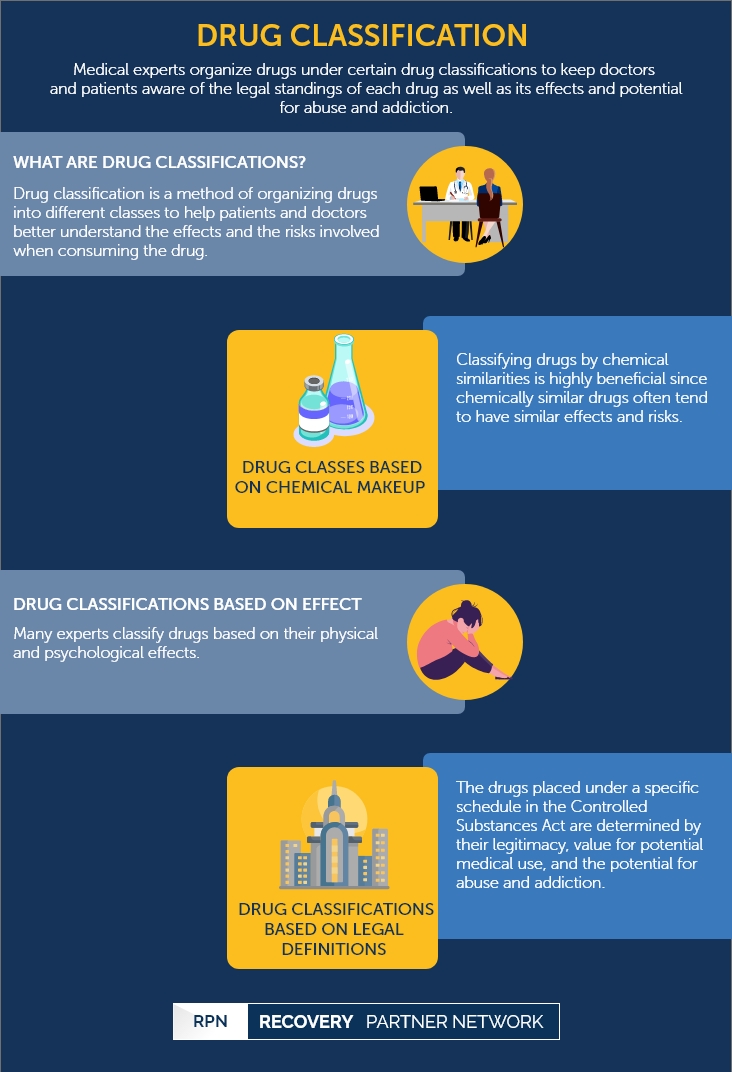Medical experts organize drugs under certain drug classifications to keep doctors and patients aware of the legal standings of each drug as well as its effects and potential for abuse and addiction.
Drug classification
Drug classification | Table of Contents
What Are Drug Classifications?
Drug classification is a method of organizing drugs into different classes. Categorizing drugs in this manner help patients and doctors better understand the effects of the drug and the risks involved when consuming them. This method can also help medical professionals effectively provide treatment for drug addictions.
Classifying drugs by chemical similarities is highly beneficial since chemically similar drugs often tend to have similar effects and risks. An individual with an addiction to a specific drug is also more likely to abuse another drug of an identical chemical structure. Additionally, understanding the chemical properties of each drug can also be beneficial when treating health conditions effectively.
There are considerable debates on how drugs should be classified, even amongst experts, which has led to drugs being classified differently depending on each country. Many experts classify drugs based on their physical and psychological effects. For instance, some drugs make users active and energetic, while others make users feel relaxed and calm. When classified in this manner, drugs may not contain any chemical similarity or hold no bearing towards its legal or illegal nature. However, they may often overlap one another.
Some countries classify drugs according to their legal nature. This system mainly focuses on the drug’s purpose or use, legal status, and the penalties involved in its procession, distribution, and manufacture. During such legal classification, drugs are generally categorized based on the perceived medical value and risks and dangers associated with the drug. Due to these differences of opinions, it is quite impossible to come up with a definite set of drug classifications. However, some of the most common drug classifications are given below.
FAQ
- What is drug classification?
- How many drug classifications are there?
- What are the five main categories of drugs?
- What are the five classes of drugs?
Drug classifications are a way to organize drugs into categories. This method helps classify drugs according to chemical similarities since chemically related drugs contain similar impacts and effects.
There are seven drug categories.
The five main categories of drugs are central nervous system depressants, stimulants, opiates/opioids, hallucinogens, and marijuana.
The five classes of drugs include stimulants, depressants, hallucinogens, narcotics, and anabolic steroids.
Drug Classes Based on Chemical Makeup
Alcohol is the most widely abused substance across the world. Legal within all 50 states of the US, alcohol consumption can cause severe and adverse short term and long term effects in an individual. Alcohol is a central nervous system depressant that produces a euphoric high when consumed, while also significantly impairing judgment, perception, inhibition, and response time in a user. Long-term consequences of alcohol may include stroke, liver damage, and heart disease.
Some of the many forms of alcohol are:
- Beer
- Wine
- Liquor
Opioids are controlled prescription drugs that are either extracted from opium or synthetic chemicals designed to mimic its chemical structure. Opioids function by interacting with the brain’s neurotransmitters and blocking the signals sent by them. Opioids are pain killers that are generally used for the treatment of moderate to severe pain. Due to its intense soothing effects, opioids hold a high potential for abuse and addiction among users. Opioid addiction is one of the gravest issues faced by America today. Opioids are some of the most addictive and deadliest of all known substances.
Some of the popular opioids are:
- Heroin
- Fentanyl
- Oxycodone
Benzodiazepines or benzos are a category of drugs that function by interacting with the neurotransmitter, gamma-aminobutyric acid-A (GABA-A.) The effects of benzodiazepines may vary as each drug tend to interact differently with GABA-A. Benzos are generally prescribed by doctors to treat several health conditions, including sleep and psychiatric disorders. These drugs are usually prescribed for short-term use due to its highly addictive nature. Prolonged use of benzos or its consumption beyond prescription can cause adverse medical and psychiatric health issues.
Some examples of benzos are:
- Ativan
- Valium
- Xanax
Cannabinoids are a class of drugs that are chemically akin to tetrahydrocannabinol (THC), the active ingredient in marijuana. Cannabinoids generate an intense high when consumed in high doses while also negatively affecting the mental and physical health of the user. Cannabinoids are the most widely abused substances after alcohol. Although it is regarded to be less addictive than other drug classifications, it does, however, hold potential for causing psychological dependence when consumed over time.
Some examples of cannabinoids are:
- Marijuana
- Hashish
Barbiturates are a class of drug that functions by weakening the central nervous system. They are sedative-hypnotics that were historically popular for treating psychiatric and sleep disorders. At present, they are used for treating various health conditions such as epilepsy and severe headaches as well as a form of anesthesia. Barbiturates are considered to be highly addictive drugs than can cause adverse and fatal effects when abused.
Some examples of barbiturates are:
- Amytal
- Luminalthis
- Pentobarbital
Drug Classifications Based on Effect
CNS depressants, commonly known as “downers,” are drugs that generate feelings of tiredness and relaxation. Although depressants hold legitimate medical functions in combating mental illnesses and sleep deprivation, they also retain a high potential for abuse due to its capacity to produce euphoric highs. Like most addictive substances, depressants can cause adverse side effects and a high potential for a fatal overdose.
Some examples of depressants are:
- Alcohol
- Opiates
- Barbiturates
The primary purpose of stimulants, also known as “uppers,” is to improve energy, concentration, and wakefulness. Stimulants provide a short-term boost of energy along with a feeling of high, that is generally believed by the user to improve productivity and performance. Prolonged use of addictive stimulants can lead to severe health issues and mental disorders. Stimulants are considered to be one of the highly addictive substances available in the world today.
Some examples of stimulants are:
- Adderall
- Cocaine
- Meth
Hallucinogens also referred to as dissociatives, modify a user’s perception of reality, resulting in auditory and visual hallucinations (a process known as tripping.) Although hallucinogens are usually less-addictive than other drug classifications, their immediate impacts are often more severe and dangerous.
Some examples of hallucinogens are:
- LSD
- Psilocybin Mushrooms
- PCP
Inhalants are a broad range of chemicals that are usually ingested by inhaling or huffing. Most inhalants may consist of every-day toxic substances found around your home. Although the effects of inhalants vary depending on the substance used, they generally produce a buzz that most users enjoy. Although not as common as other forms of addiction, inhalant addiction is still a serious issue amongst young adults and teenagers as it causes adverse physical and psychological effects that can last a lifetime.
Some examples of commonly-abused inhalants are:
- Paint thinner
- Nail polish remover
- Gasoline
Drug Classifications Based on Legal Definitions
The Federal Government declared the Controlled Substances Act in 1970 as a response to the growing drug epidemic. Five classifications or schedules were established under the act, and the drugs that are placed under a specific schedule are determined based on key factors such as the legitimacy and value for potential medical use and the potential for abuse and addiction. However, there may be some exceptions due to consular agreements. The US may class certain drugs into a particular schedule in accordance with diplomatic agreements, for example, the Single Convention on Narcotic Drugs.
Schedule I drugs have the harshest penalties and the most regulations of any drug classifications. Schedule I drugs have no legitimate medical uses and a high potential for abuse and addiction.
Some examples of Schedule I drugs are:
- Ecstasy
- Quaaludes
- GHB
Schedule II drugs have harsh penalties and high regulations compared to the drug classifications stated below. Although Schedule II drugs have legitimate medical purposes, they also hold very high potential for abuse and addiction.
Some examples of Schedule II drugs are:
- Codeine
- Methadone
- Ritalin
Schedule III drugs have a legitimate medical purpose and a moderate potential for abuse and addiction compared to Schedule I and II drugs. This drug classification consists of strict drug regulations and penalties, although not as severe as Schedule I and II.
Some examples of Schedule III drugs are:
- Anabolic steroids
- Ketamine
- Vicodin
Schedule IV drugs have penalties and regulations that fall in between those of Schedule V and Schedule III drugs. Schedule IV drugs have legitimate medical functions and fewer potential for abuse and addiction compared to other potent medications.
Some examples of Schedule IV drugs are:
- Ambien
- Darvocet
- Tramadol
Schedule V drugs have the lowest penalties and fewest regulations out of any federal drug classifications. These drugs have legitimate medical purposes and the lowest potential for abuse and addiction compared to Schedule IV drugs.
Some examples of Schedule V drugs are:
- Lomotil
- Motoren
- Lyrica
FAQ
- What is the difference between drug classes and schedules?
- What is a Schedule I drug?
- Who is responsible for classifying drugs?
- What are the illegal classes of drugs?
These are two different ways of organizing drugs. Drug classes are organized according to the main properties of a drug, while drug scheduling depends on the drug’s medical use and its potential for abuse and dependence.
Schedule I drugs are substances with no medical application and a very high potential for abuse. Examples of such substances may include LSD, ecstasy, and heroin.
The federal Controlled Substances Act (CSA) is responsible for classifying drugs based on their potential for abuse and their medical use.
There are four main categories of illicit drugs, such as stimulants, depressants, narcotics, and hallucinogens.
Recovery Partner Network
We aim to educate and empower. If you feel our library of resources does not cover your specific need, reach out to us, and we would be happy to help.
STATISTICS
© Copyright 2025


